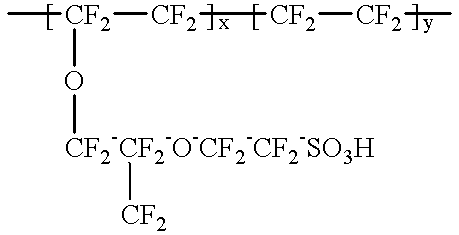Composite solid polymer elecrolyte membranes
a solid polymer and elecrolyte technology, applied in the field of composite solid polymer elecrolyte membranes, can solve the problems of reducing proton conductivity, swelling of the membrane, and environmental problems of powered internal combustion engines, and achieves the effects of improving strength, processability, or stability, fuel crossover resistance, and hydrolytic stability
- Summary
- Abstract
- Description
- Claims
- Application Information
AI Technical Summary
Benefits of technology
Problems solved by technology
Method used
Image
Examples
example 1
Sulfonation of Radel R.RTM. Using Sulfan B.RTM. (100% and 150% Stoichiometric Sulfonation)
[0216] Sulfonation Procedure I was used in the following example.
[0217] Two separate 1000 ml 3 neck resin kettles (with ribs) equipped with an N.sub.2 inlet, addition funnel, and overhead stirrer were charged with the following reactants: 340 ml of dichloromethane and 50.00 grams of Radel R.RTM. Polyphenylsulfone Polymer (beads). These mixtures were stirred until solutions formed (approximately 0.25 hours). Once solutions formed, they were cooled in ice baths to about a temperature of 0.degree. C. (ice bath was maintained throughout the duration of the addition and reaction). (Note that Radel R.RTM. was dried at 70.degree. C. under full dynamic vacuum for about 12 hours to remove any adsorbed moisture.)
[0218] While the above solutions were cooling, the following amounts of Sulfan B.RTM. were combined with dichloromethane in two separate 125 ml addition funnels. In funnel #1 (100% sulfonation) 1...
example 2
Sulfonation of Radel R.RTM. Using Sulfan B.RTM. at 200% Stoichiometric Sulfonation
[0234] Procedure
[0235] This sulfonation reaction was run very similarly to those previously described in Example 1 (100, 150% sulfonations with Sulfan B.RTM.), with minor adjustments, which are noted below:
[0236] After the precipitation of the polymer from the initial dichloromethane solutions, only 200 ml of new solvent was added to enhance stirring (in Example 1, an additional 350 ml was used).
[0237] Previous data suggests that not all of the SO.sub.3 reacts with the polymer over 6 hours at 0-5.degree. C. Therefore, one reaction was carried out at ice bath temperatures for 8 (or more) hours and then allowed to warm to room temperature. Although the resulting sulfonated Radel R.RTM. was darker in color than the batch that was quenched after only 6 hours, the polymer was still water insoluble and showed good film properties. The properties of such ICPs are:
[0238] 200% Sulfonated Radel R (quenched after...
example 3
Sulfonation of BASF Ultrason.RTM. Polyether Sulfone Using Sulfan B.RTM. (85%, 75%, and 65% Sulfonation)
[0244] Sulfonation Procedure III was used in the following example.
[0245] Three separate 1000 ml 3 neck resin kettle (with ribs) equipped with an N.sub.2 inlet, addition funnel, and overhead stirrer were charged with the following reactants: the first resin kettle was charged with 350 ml of dichloromethane and 51.00 grams of BASF Ultrason polyether sulfone polymer (fine powder), the second was charged with double the amount of reactants, and the third was charged with the same ratios as the first. Ultrason was dried at 70.degree. C. under dynamic vacuum for about 12 hours prior to use. These mixtures were stirred until solutions formed (approximately 15 min.). Once solutions formed, they were cooled in ice baths to about a temperature of 0.degree. C. (ice bath was maintained throughout the duration of the addition and reaction).
[0246] While the above solutions were cooling, the fol...
PUM
| Property | Measurement | Unit |
|---|---|---|
| temperatures | aaaaa | aaaaa |
| pore size | aaaaa | aaaaa |
| pore size | aaaaa | aaaaa |
Abstract
Description
Claims
Application Information
 Login to View More
Login to View More - R&D
- Intellectual Property
- Life Sciences
- Materials
- Tech Scout
- Unparalleled Data Quality
- Higher Quality Content
- 60% Fewer Hallucinations
Browse by: Latest US Patents, China's latest patents, Technical Efficacy Thesaurus, Application Domain, Technology Topic, Popular Technical Reports.
© 2025 PatSnap. All rights reserved.Legal|Privacy policy|Modern Slavery Act Transparency Statement|Sitemap|About US| Contact US: help@patsnap.com



